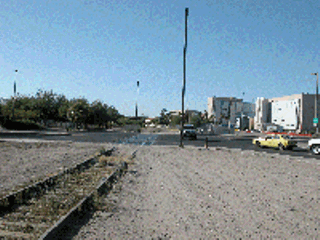In that case, a bundle of new revenue sources was tied together, and taxpayers were told the naming rights, car-rental taxes, RV fees and lease arrangements would cover the baseball facility's construction and operating costs. The reality of time showed they fell several million dollars short of the goal.
The city is considering building a new arena near Congress Street and Interstate 10 to replace the nearby 34-year-old facility, as soon as 2007 (See "Arena Agenda," Jan. 8, 2004). While local price projections are sketchy, Albuquerque is thinking of spending $90 million for its own new facility.
To cover the construction costs of the proposed building, Assistant Tucson City Manager, Karen Thoreson, says: "We're looking hypothetically at eight or 10 sources and a combination of things." These could include event ticket surcharges, parking fee increases and the use of Rio Nuevo project money.
Approved by the voters in 1999, the downtown revitalization project receives funds through tax incremental financing. Generated from a district which stretches out Broadway Boulevard all the way to Park Place, sales-tax receipts which are above an established baseline are used to finance bonds to pay for one-third the cost of Rio Nuevo improvements. The balance is supposed to come from other sources of money.
If Rio Nuevo money is used on the new arena, Thoreson indicates the remainder could be realized from the use of even more tax incremental financing. These funds might be generated from a rejuvenated downtown civic plaza, the centerpiece of which would be the new arena.
Another possibility, Thoreson offers, would be for the Rio Nuevo pot to cover more than a third the cost of the arena.
"The City Council has not kept a strict standard on the one-third amount," she says. "In the case of the Tucson Origins (historic preservation and revitalization) project, Rio Nuevo funds covered the entire cost. But we're not looking at 100 percent of the debt service for the arena to be paid for by Rio Nuevo funds."
One potential revenue source Thoreson immediately rules out is a sales-tax increase. "I don't think the community will support that," she stresses.
But a higher sales tax is exactly how communities around the country paid for three of the five new arenas visited by local leaders earlier this year. And the increases weren't necessarily controversial.
In Corpus Christi and Laredo, Texas, voters approved an eighth- and quarter-cent sales tax increase, respectively, to help pay for their new arenas. According to Matthew Sturdevant of the Corpus Christi Caller-Times, it wasn't the tax increase which upset people, but cost overruns experienced during the building's construction.
"The price increase through (13) change orders was $3.9 million more than the original $35.5 million estimate," he says. "That was almost an 11 percent increase, and people got frustrated with that."
Despite the cost overruns, Sturdevant thinks the people of Corpus Christi are very pleased with their new 8,400-seat arena. The previous building, he recalls, had bad acoustics, looked like an airplane hanger and only attracted acts which were "just emerging or limping along." Now the community is seeing bigger-name attractions which are drawing larger crowds, the same result as achieved in Laredo.
Despite those perceived advantages, it isn't only controlling the construction cost which can be troublesome with a new arena. The annual operating expenses might also be a burden.
Five years ago, Bossier City, La., opened a new arena which seats more than 14,000. Tom Williams, its general manager, says the building costs $3 million a year to run, funds which so far have been covered by the facility. "That's a rarity," Williams adds, "and never a sure thing."
Craig Baltzer, general manager of the 2-year old, 9,600-seat arena in Laredo, Texas, concurs with that assessment. "During our honeymoon year," he says, "we did very well. We've been in the black since then, but it is a concern for us. These places don't make money, and in bad years, you try to break even."
To estimate both the construction and operating costs for a new Tucson arena, the city is paying $80,000 to the consulting firm of Conventions, Sports and Leisure. Rich Singer, director of the Tucson Convention Center, expects the results within a few months.
"It's a very market-driven study," Singer says. "How many seats will the market support along with revenues from things like naming rights and hospitality suites?" Singer also includes club seating and sponsorships as other potential funding sources, and concludes: "More often than not, arenas can cover their operating costs out of their revenues."
Singer emphasizes that the current TCC now loses about $3 million a year in operating expenses. But because of bookkeeping procedures, he can't say how much of that is attributable to the existing arena alone.
Because of the artistic and community groups which use the TCC, including its Music Hall and Leo Rich Theater, Singer admits a portion of the current debt is reasonable. "Some of that is appropriate," he says.
Before its opening day, taxpayers were also told Tucson Electric Park would pay its own way. Time showed otherwise.
Singer, though, is confident the financial questions about a new Tucson arena can be resolved differently. "An arena could and should break even," he believes.










